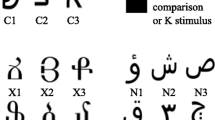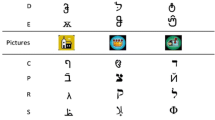Abstract
Two experiments were conducted to study stimulus equivalence as a function of class size and number of classes. In the first experiment, equivalence was tested in 50 normal adult subjects following a linear series training structure. Subjects were successively assigned to either of 10 groups, exposed to a specific stimulus material. For subjects in which number of classes increased, up to six, B-stimuli served as pictures, while A-, and C-stimuli were Greek letters, and “equivalence” was tested in CA tests. The A-, B-, and C-stimuli were the same for ail subjects in whom class members increased up to six, where D-, E- and F-stimuli were Greek letters. Following AB, BC, CD, DE, and FE training, FA, EA, FB, FC, EB, DA, FD, EC, DB, and CA “equivalence” tests were run. In the second experiment, a many-to-one training structure was used to study equivalence as a function of increasing class size without increase number of nodes. The results indicate that the probability of equivalence decreased more as function the number of nodes than as a function of number of classes. Reaction times, particularly to the comparison stimuli, generally increased initially during tests, possibly indicating precurrent problem solving behavior prior to the response to a comparison stimulus.
Similar content being viewed by others
References
ARNTZEN, E., & HOLTH. P. (1997). Probability of stimulus equivalence as a function of training design. The Psychological Record, 47, 309–320.
BARNES, D., MCCULLAGH, P. D., & KEENAN, M. (1990). Equivalence class formation in non-hearing impaired children and hearing impaired children. The Analysis of Verbal Behavior, 8, 19–30.
BUFFINGTON, D. M., FIELDS, L., & ADAMS, B. J. (1997). Enhancing equivalence class formation by pretraining of other equivalence classes. The Psychological Record, 47, 69–96.
BUSH, K. M., SIDMAN, M. & De Rose, T. (1989). Contextual control of emergent equivalence relations. Journal of the Experimental Analysis of Behavior, 51, 29–45.
DEVANY, J. M., HAYES, S. C., & NELSON, R. O. (1986). Equivalence class formation in language-able and language-disabled children. Journal of the Experimental Analysis of Behavior, 46, 243–257.
FIELDS, L., ADAMS, B. J., & VERHAVE, T. (1993). The effects of equivalence class structure on test performances. The Psychological Record, 43, 697–712.
FIELDS, L., REEVE, K. F., ROSEN, D., VARELAS, A., ADAMS, B. J., BELANICH, J., & HOBBIE, S. A. (1997). Using the simultaneous protocol to study equivalence class formation: the facilitating effects of nodal number and size of previously established equivalence classes. Journal of the Experimental Analysis of Behavior, 67, 367–389.
FIELDS, L., & VERHAVE, T. (1987). The structure of equivalence classes. Journal of the Experimental Analysis of Behavior, 48, 317–332.
FIELDS, L., VERHAVE, T., & FATH, S. (1984). Stimulus equivalence and transitive associations: A methodological analysis. Journal of the Experimental Analysis of Behavior, 42, 143–157.
GREEN, G., & SAUNDERS, R. R. (1998). Stimulus equivalence. In K. A. Lattal & M. Perone (Eds.), Handbook of research methods in human operant behavior (pp. 229–262). New York: Plenum Press.
HARING, T. G., BREEN, C. G., & LAITINEN, R. E. (1989). Stimulus class formation and concept learning: Establishment of within- and between-set generalization and transitive relationship via conditional discrimination procedures. Journal of the Experimental Analysis of Behavior, 52, 13–25.
HOLTH, P., & ARNTZEN, E. (1998a). Stimulus familiarity and the delayed emergence of stimulus equivalence or consistent nonequivalence. The Psychological Record, 48, 81–110.
HOLTH, P., & ARNTZEN, E. (1998b). Symmetry versus sequentiality related to prior training, sequential dependency of stimuli, and verbal labeling. The Psychological Record, 48, 293–315.
au]HOLTH, P., & ARNTZEN, E. (in press). Reaction times and the emergence of class consistent responding: A case for precurrent responding?
KENNEDY, C. H. (1991). Equivalence class formation influenced by the number of nodes separating stimuli. Behavioural Processes, 24, 219–245.
KENNEDY, C. H., & LAITINEN, R. E. (1988). Second-order control of symmetric and transitive stimulus relations: The influence of order effects. The Psychological Record, 38, 437–446.
SAUNDERS, R. R., & GREEN, G. (1999). A discrimination analysis of training-structure effects on stimulus equivalence outcomes. Journal of the Experimental Analysis of Behavior, 72, 117–137.
SAUNDERS, R. R., WACHTER, J. A., & SPRADLIN, J. E. (1988). Establishing auditory stimulus control over an eight-member equivalence class via conditional discrimination procedure. Journal of the Experimental Analysis of Behavior, 49, 95–115.
SIDMAN, M. (1994). Equivalence relations and behavior: A research story. Boston: Authors Cooperative.
SIDMAN, M., KIRK, B. & WILLSON-MORRIS, M. (1985). Six members stimulus classes generated by conditional-discrimination procedures. Journal of the Experimental Analysis of Behavior, 43, 21–42.
SIDMAN, M. & TAILBY, W. (1982). Conditional discrimination vs. matching to sample: An expansion of the testing paradigm. Journal of the Experimental Analysis of Behavior 37, 5–22.
SIDMAN, M., WILLSON-MORRIS, M. & KIRK, B. (1986). Matching-to-sample procedures and the development of equivalence relations: The role of naming. Analysis and Intervention in Developmental Disabilities, 6, 1–29.
SPENCER, T. J. & CHASE, P. N. (1996). Speed analysis of stimulus equivalence. Journal of the Experimental Analysis of Behavior, 65, 643–659.
Author information
Authors and Affiliations
Corresponding author
Rights and permissions
About this article
Cite this article
Arntzen, E., Holth, P. Probability of Stimulus Equivalence as a Function of Class Size vs. Number of Classes. Psychol Rec 50, 79–104 (2000). https://doi.org/10.1007/BF03395344
Published:
Issue Date:
DOI: https://doi.org/10.1007/BF03395344




